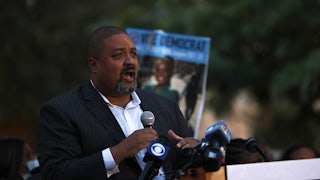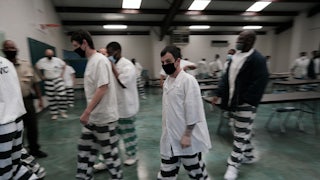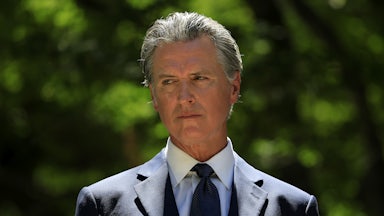The images spread quickly on social media: railroad tracks strewn with empty cardboard boxes, packing material, heaps of bubble wrap. These photos and videos, of a Union Pacific railway hub in Los Angeles beset by package thieves, seemed straight out of a “post-apocalyptic film,” one New York Times newsletter writer mused. It wasn’t just junk, another Times article reminded us: “A family photograph, propped up in the garbage, stands sentimental to someone, somewhere, but of no interest to those who loot the tracks of Lincoln Heights.”
It was just the latest spectacle in a string of instances of theft, mostly in California, that have gone viral online and been disseminated with nearly as much speed by local and national media. Last month, the country was transfixed by burglars streaming out of a luxury department store with armfuls of merchandise; this month, we’re aghast at modern-day railroad bandits with no regard for family treasures. The visual potency of these thefts has presented a thrilling opportunity for the tough-on-crime crowd: police unions, prosecutors’ associations, the retail lobby. And there are plenty of scapegoats: progressive prosecutors, sentencing reform, the “Defund the Police” movement, the “Defund the Police” slogan.
Union Pacific publicized a letter that its general director sent to Los Angeles District Attorney George Gascón, criticizing his office for supposedly failing to prosecute those apprehended on the tracks. “People are stealing because they know they can get away with it,” said the president of the California Retailers Association. “Criminals frankly know Prop. 47 better than most of us do,” she added, referencing a 2014 ballot measure that reduced some crimes, including shoplifting less than $950 worth of goods, from felonies to misdemeanors. “It’s a manifestation of deciding we’re going to defund the cops,” said Rick Caruso, the Los Angeles developer and prospective mayoral candidate, after the Nordstrom at one of his malls was robbed. “It’s a manifestation of deciding we’re not going to prosecute crimes.”
Never mind that no such defunding took place—on the contrary, L.A.’s latest budget increases the money allocated to police. Never mind that Union Pacific laid off a number of its security staff in September 2020, blaming these layoffs on budgetary issues, that the company went on to record its most profitable year ever in 2021, or that its annual revenue exceeds that of the city of Los Angeles. Never mind that the LAPD’s own data shows that property crime is down. The story—that these thefts represented an utter repudiation of the demands of the 2020 protests and a decade of painstaking decarceral reform in California—had already coalesced.
California’s Democratic politicians, fresh off a year of trying to appease protesters’ demands with pledges to “reimagine policing” and effect “fundamental change,” immediately ceded every ounce of narrative authority to tough-on-crime voices, and with such gusto that it gave cause to wonder whether the idiom of law and order had been their native language all along. San Francisco Mayor London Breed: “It’s time that the reign of criminals who are destroying our city, it is time for it to come to an end.” Representative Nancy Pelosi: “There is an attitude of lawlessness in our country that springs from I don’t know where … and we cannot have that lawlessness become the norm.” Governor Gavin Newsom: “I have no sympathy, no empathy whatsoever, for people smashing and grabbing, stealing people’s items, creating havoc and terror on our streets.”
Already, the governor has unveiled a $300 million plan to combat retail theft, which largely consists of more money for police. He has announced a new multi–law enforcement agency taskforce to combat rail theft in L.A. Mayor Breed, in San Francisco, has proposed to expand police access to private surveillance footage across the city. (It is telling that more resources have been marshaled, more outraged expressed, for retail theft than for murder, which has spiked recently in Los Angeles and Oakland; or that the two issues are often brought up together, as inextricable and equally significant harbingers of a growing culture of “lawlessness.”)
As Democratic politicians rush to confer more money and power on law enforcement, the right’s most concrete and insistent policy demands have been in the direction of Proposition 47. “I think it was the biggest con job in California history,” said Sacramento District Attorney Anne Marie Schubert, who will challenge Rob Bonta for California attorney general this year. “The easiest way to reduce crime is to fix Proposition 47 and reimpose strong sentencing for the pervasive retail theft that is literally closing stores across our state,” intoned the vice president of the San Francisco Police Officers Association.
Newsom has clarified that he doesn’t think Prop. 47 is responsible for recent retail theft cases, a practically useless remark given that his invocations of “havoc and terror” have already lent credence to the narrative that the retail and police lobby are pushing. California voters should not be surprised to find another challenge to Proposition 47 on the ballot in the coming years. And law enforcement unions might not even have to fight to place it there—on the very first day of the 2022 California legislative session, Democratic state lawmaker Rudy Salas introduced a bill to lower the dollar amount for petty theft to qualify as a felony from $950 to $400.
Before California undoes a measure that has been settled law for seven years now, it might behoove us to remember how Proposition 47 came about in the first place. In 2011, the Supreme Court ordered California to reduce its state prison population immediately on the grounds that the severe overcrowding endemic to the system violated the Constitution’s prohibition against cruel and unusual punishment. At the time, California’s state prisons were at 200 percent capacity: 160,000 people living in facilities meant to warehouse 80,000. In practical terms, this meant such a pervasive lack of medical care that, as then–Supreme Court Justice Anthony Kennedy found, an incarcerated person died a preventable death every six to seven days. It meant over 50 people forced to use a single toilet; it meant as many as three men sharing a six-by-nine-foot cell. It meant suicide rates 80 percent higher than those of the rest of the country’s prisons.
The Supreme Court ruling required the state to release people until the prison population reached a mere 137.5 percent of its intended capacity. Prop. 47 came about as a response: 59.61 percent of California voters approved the ballot measure back in 2014. Nearly 62 percent upheld it in 2020. Among the opposition: the California Police Chiefs Association, the California Retailers Association, and the Chamber of Commerce. Today, the state prison population has come down far enough that California is closing two of its prisons. The system still remains over 100 percent capacity, a level of crowding that has proved hazardous to life and health during the Covid-19 pandemic.
The image of the Lincoln Heights rail hub is a powerful and arresting one, but so is the image of an overcrowded prison, if we care to look. The argument we are being called to accept here says that the vision of train tracks covered in packing and shipping detritus is of more significance than the specter of dozens of men forced to share a single toilet, or prisoners growing old and sick behind bars, living out their days without a minimum standard of medical care. Many people may still accept it, but they should know that it is the choice they’re making, and understand who is asking them to make it.






